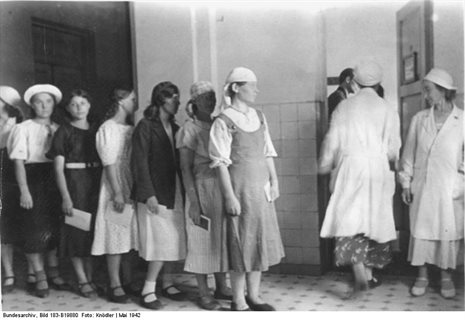Making women work: gender, race and labour in Nazi-occupied Europe
Project summary
The project (September 2017-August 2020) explores the gender dimension of the Nazi war economy’s use of foreign labour. It asks how the German labour administration in different parts of occupied Europe treated women workers of different nationalities and ‘racial’ categories. Why were hundreds of thousands of girls and women from Poland and the occupied Soviet territories deported to work in Germany, and relatively few dispatched, with much lower degrees of compulsion, from occupied Western Europe?
The project also takes a fresh look at the mobilisation of German women workers within the war economy. Did the regime hesitate about conscripting the final reserves of German women for war work because a reserve of foreign women was available? And how did the belated mobilisation in 1943 and 1944 of new supplies of German female labour affect the employment patterns of foreign women?

German labour office in Artjomowsk, Ukraine, May 1942: Ukrainian women about to be transported to Germany to be deployed as forced labour queue up for a medical check. Source: Bundesarchiv. Bild 183-B19880. Photographer: Knödler.
http://creativecommons.org/licenses/by-sa/3.0/de/legalcodeLicence CC-BY-SA 3.0
Using examples from occupied East Upper Silesia and occupied Belgium as well as the German Reich itself, I show how employers and the labour administration in Germany and in the occupied territories treated foreign and Jewish women as a particularly elastic ‘reserve’ of labour, detached from their domestic role and displaced to other locations at short notice. As forced labourers, women from Poland and the occupied Soviet territories and Jewish women were paid even less than their male counterparts, but not subject to gendered restrictions regarding heavy or dangerous work.
Meanwhile, the domestic role and responsibilities of German women workers provided the basis for privileges that set them above and apart from foreign women workers, for instance, regarding options for part-time work and protective legislation. But there were German women too, particularly from marginalised social categories, who were stigmatised as ‘workshy’ and harshly disciplined in ‘labour education camps’, prisons and concentration camps.
Publications
‘Last resort or key resource? Women workers from the Nazi-occupied Soviet territories, the Reich Labour Ministry and the German war effort’, in Transactions of the Royal Historical Society 26 (2016), 149-173
‚Frauenarbeit in der NS- und in der Kriegswirtschaft‘, in Marcel Boldorf and Jonas Scherner (eds), Wirtschaft im Nationalsozialismus und im Zweiten Weltkrieg (forthcoming)
Presentations
Public lecture, Topographie des Terrors, Berlin, 17 September 2019, ‚NS-Zwangsarbeit und die Kategorie
« Geschlecht »: Ein Forschungsfeld‘
Public lecture, Miller Center for Holocaust Studies, University of Vermont, Burlington, 23 October 2019, ‘Making women work: privilege and powerlessness in Nazi Germany’